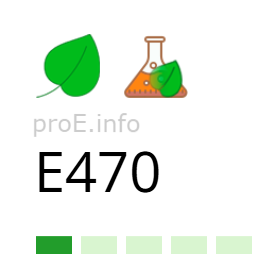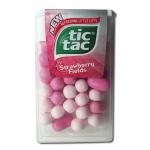
Other names for the additive (synonyms)
General Information
According to the Codex Alimentarius, the food additive E470 (INS 470) is a general designation for a group of fatty acid salts (including salts of aluminum, calcium, sodium, magnesium, potassium, and ammonium).
Functionally, these compounds are used in the food industry mainly as anti-caking agents / agents to prevent clumping, as well as emulsifiers and stabilizers in certain technological processes.
Additive E470 includes three types of compounds:
- INS 470(i) — Salts of myristic, palmitic, and stearic acids with ammonium, calcium, potassium, and sodium;
- INS 470(ii) — Salts of oleic acid with calcium, potassium, and sodium;
- INS 470(iii) — Magnesium stearate.
In EU Regulation (EC) No 1333/2008, two additives are mentioned as permitted for use in the food industry:
- E470a — Sodium, potassium, and calcium salts of fatty acids (corresponding to additive INS 470(i))
- E470b — Magnesium salts of fatty acids (including additive INS 470(iii))
In nature, free fatty acids (e.g., palmitic, stearic, oleic) are widespread in plant and animal lipids; their salts (stearates, palmitates, etc.) are more often produced artificially during industrial processing — thus, for the food sector, E470 is obtained by neutralizing isolated or synthetically produced fatty acids with the corresponding bases or metal/ammonium salts.
Industrial processing usually involves the hydrolysis of fats to release free fatty acids, followed by neutralization or direct precipitation of the corresponding salt (for example, treating a stearic acid solution with sodium/potassium hydroxide or magnesium/calcium salts). For magnesium and calcium salts, controlled precipitation at a specific pH and temperature is often carried out, followed by drying and milling to the required particle size.
Typical examples of E470 additives include calcium stearate, magnesium stearate, sodium palmitate, and potassium oleate. In appearance, these are most often white or nearly white fine powders or granules. Sodium and potassium salts are relatively more hydrophilic and water-soluble, whereas calcium and magnesium stearates are poorly soluble in water and form stable microfilms.
In industry, the production of additives E470a and E470b more often relies on plant-based raw materials (palm, coconut, and soybean oils) due to their lower cost, availability, and reduced risk of causing concern among some consumers regarding animal-derived sources.
Effect on the Body
Benefits of additive E470
Additive E470 (and its specific forms: E470a, E470b) are essentially derivatives of edible fats and fatty acids, which do not possess specific pharmacological activity and dissociate in the gastrointestinal tract into fatty acid carboxylates and the corresponding cations. Fatty acids are rapidly and completely absorbed and metabolized through β-oxidation and the Krebs cycle.
Risks of additive E470
Potential risks of consuming E470 are mainly associated with trans fats and impurities that may be present in fatty acid salts as a result of synthesis.
The EFSA Panel on Food Additives and Nutrient Sources added to Food, in its 2017 report, recommended:
- Reducing the maximum permissible levels of toxic elements (As, Pb, Hg, Cd).
- Establishing maximum levels of trans fatty acids.
- Clarifying that fatty acids for production must be derived only from edible fats and oils.
The Committee also noted that the contribution of E470a and E470b additives to total saturated fat intake is no more than 5% of the total intake from food.
Studies have confirmed the absence of toxicity, genotoxicity, and carcinogenicity for E470a and E470b.
Therefore, in its evaluation of E470 additives, the EFSA Panel stated that there is no need to establish an Acceptable Daily Intake (ADI) and that the Panel has no safety concerns for E470 additives at the specified uses and levels.
In the scientific literature, there is discussion about cumulative dietary aluminum intake and potential risks from its chronic accumulation. However, aluminum salts of fatty acids are not used in the food industry in the European Union and are not part of the permitted E470a and E470b additives.
Uses
In the food industry, E470 and its subtypes are mainly used as:
- anti-caking agents — in dry mixes (spices, powder blends, instant drinks, milk substitutes),
- lubricants and release agents — in confectionery production, during molding and baking,
- components of technological blends — where control of flowability, adhesion, or moisture is required.
The choice of specific salt depends on the required solubility and effects: sodium/potassium salts are used for water solubility, while magnesium or calcium stearates are chosen for low solubility and strong release effects. E470 is used in very small amounts, guided by technological needs (usually hundredths to tenths of a percent of the product's total weight).
E470 can also be found in chewing gum and mints — it forms a thin fatty film on the surface, preventing gum from sticking to equipment, packaging, or teeth.
Outside the food industry, fatty acid salts are used in detergent production and in the pharmaceutical industry as excipients in tablet manufacturing.
Legal Status
In Europe, additives E470a and E470b are permitted for use in the food industry in accordance with Regulation (EC) No 1333/2008.
Ukraine follows EU legislation regarding the list of permitted additives, so E470 is used in the food industry in Ukraine.
In the United States, many stearates are considered GRAS and are permitted as processing aids in food manufacturing.
In addition, additive E470 is approved for use in food production in Canada, Japan, and other countries.
